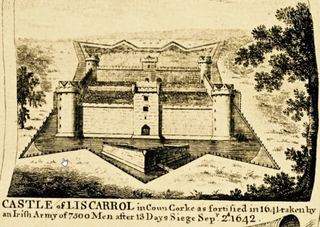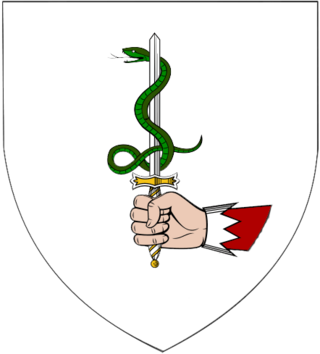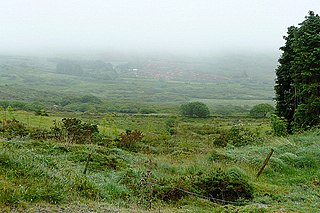
The Battle of Liscarroll was fought on 3 September 1642 in northern County Cork, Munster, between Irish Confederate and Royalist troops. The battle was part of the Irish Confederate Wars, which had started in the north in 1641 reaching Munster in 1642. The Confederates, about 8,500 strong, were led by Garret Barry, an Irish veteran from the Spanish Army of Flanders. The Royalist forces, about 2,400 strong, were commanded by Murrough O'Brien, 6th Baron of Inchiquin, an Irish Protestant. Despite his numerical disadvantage Inchiquin routed his enemies by the strength of his cavalry and the firepower of his musketeers.
Túath is the Old Irish term for the basic political and jurisdictional unit of Gaelic Ireland. Túath can refer to both a geographical territory as well the people who lived in that territory.

The O'Donovan family is an ancient Irish noble family. Their patronymic surname derives from Irish Ó Donnabháin, meaning the grandsons or descendants of Donnubán, referring to the 10th century ruler of the Uí Fidgenti, Donnubán mac Cathail. During the 12th and 13th century, O'Donovan relations relocated from the Bruree/Croom area south to the Kingdom of Desmond and to Carbery, where they were a ruling family for centuries and played a role in the establishment of a feudal society under the MacCarthys. Other septs retreated into the southeast corner of the Ui Fidgheinte territory, reaching from Broadford/Feenagh to the Doneraile area. The northern septs of the O'Donovans did not use a White Rod as the family's position in their original territory was vastly eroded, while several septs of O'Donovans in the southwest territories were semi-autonomous flatha under the MacCarthy Reagh dynasty in Carbery, with the most notable being local petty kings. The family were counted among the leading Gaelic nobility of Ireland.
Eóganacht Raithlind or Uí Echach Muman are a branch of the Eóganachta, the ruling dynasty of Munster in southwest Ireland during the 5th-10th centuries. They took their name from Raithlinn or Raithleann described around the area of Bandon, in the same area. Archaeologists believe that Garranes Ringfort in Templemartin parish, near Bandon, County Cork may have been Rath Raithleann, the royal seat of the Éoganacht Raithleann. They are descended from Mac Cass, the son of Conall Corc, the first King of Cashel, through Mac Cass' son Echu.
Carbery East is a barony in County Cork in Ireland. It has been split since the nineteenth century into East and West Divisions.

Carbery, or the Barony of Carbery, was once the largest barony in Ireland, and essentially a small, semi-independent kingdom on the southwestern coast of Munster, in what is now County Cork, from its founding in the 1230s by Donal Gott MacCarthy to its gradual decline in the late 16th and early 17th centuries. His descendants, the MacCarthy Reagh dynasty, were its ruling family. The kingdom officially ended in 1606 when Donal of the Pipes, 17th Prince of Carbery chose to surrender his territories to the Crown of England; but his descendants maintained their position in Carbery until the Cromwellian confiscations, following their participation in the Irish Rebellion of 1641 after which some emigrated to the Chesapeake Colonies.
Domhnall Got Mac Cárthaigh, died 1251, was the ancestor of the MacCarthy Reagh [Riabhach] dynasty of Carbery in the south of Munster in Ireland, and King of Desmond from 1247 or 1248 until the time of his death, after holding the position of tánaiste from 1230.

The barony of Mohill is an ancient barony in County Leitrim, Ireland.
Maughanasilly Stone Row is a stone row and National Monument located in County Cork, Ireland.

Upperthird or Upper Third is a barony in County Waterford, Ireland.

Athlone South, also called South Athlone, is a barony in County Roscommon, Ireland. Baronies were mainly cadastral rather than administrative units. They acquired modest local taxation and spending functions in the 19th century before being superseded by the Local Government (Ireland) Act 1898.

Clanmahon is a barony in County Cavan, Ireland. Baronies were mainly cadastral rather than administrative units. They acquired modest local taxation and spending functions in the 19th century before being superseded by the Local Government (Ireland) Act 1898.

Loughtee Lower, or Lower Loughtee, is a barony in County Cavan, Ireland. Baronies were mainly cadastral rather than administrative units. They acquired modest local taxation and spending functions in the 19th century before being superseded by the Local Government (Ireland) Act 1898.

Kilmacrenan, sometimes spelled Kilmacrennan, is a barony in County Donegal, Ireland. Baronies were mainly cadastral rather than administrative units, which acquired modest local taxation and spending functions in the 19th century before being superseded by higher units under the Local Government (Ireland) Act 1898. Kilmacrenan is the largest barony in Ireland by land area.

Tynte's Castle is a tower house located in Youghal, eastern County Cork, Ireland.

Christ Church is a deconsecrated Anglican church located in Kilbrogan, Bandon, County Cork, Ireland. The oldest surviving post-Reformation Protestant church in Ireland, it was completed circa 1610. It is dedicated to Jesus Christ, and was part of the Diocese of Cork, Cloyne, and Ross. It is currently in use as the West Cork Heritage Centre.

Condons and Clangibbon is a historical barony in County Cork, Ireland.

Ibane and Barryroe is a historical barony in southern County Cork, Ireland.
















